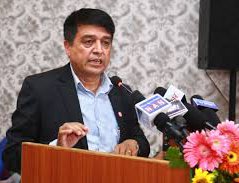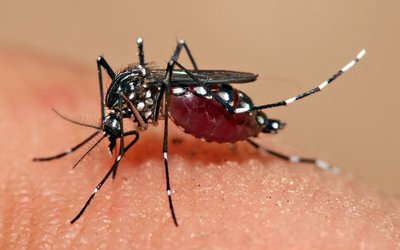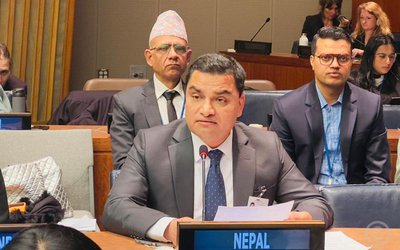
Prime Minister KP Sharma Oli’s secretariat recently confirmed 68 infections of COVID-19 along with his personal physician, principal secretary, foreign affairs advisor and press advisor.
Supreme Court has announced a temporary suspension of the hearing in the larger bench following infections among the justices, employees of the court and lawyers.
This is not last here. Prominent industrialist and banker Chandra Prasad Dhaka, who is leading candidates for first senior vice-president of Federation of Nepalese Chamber of Commerce and Industries, has also infected by COVID-19. Following treatment, he has already discharged from the hospital.
The situation with Parliament and members of local municipalities and others is the same as COVID-19 has already penetrated deep inside the community infecting a large segment of the population.
Although Kathmandu valley has been recording the largest number of COVID-19 cases, other bigger cities have a similar situation. Out of 10, 5000 cases until October 10, sixty percent of infections were in Kathmandu district alone.
In the last month alone, over 60 thousand cases were reported in Kathmandu Valley. As the festival season is approaching, the situation is likely to get worse. “If we continue to violate the health protocols, visiting crowded markets for festival purchase, our health system will be unable to cope with the burden of patients,” said Professor Dr. Jageshwor Gautam, spokesperson of the Ministry of Health and Population. “I humbly request all to remain inside the home. Go outside only if it is necessary,” said Professor Dr. Gautam.
His humble plea does not have any impact. Ministry of Culture, Tourism and Civil Aviation is working to open the temples and religious shrines before the Dashain. Experts have already warned that this will further intensify the pandemic which will go out of control.
At a time when Kathmandu Valley has been reporting over 1500 cases daily with the hospitalization rate getting higher by the day, the government is yet making any emergency plan.
“We request all COVID-19 patients to remain in home isolation not to visit the hospital until a serious trouble arises,” urged Professor Dr. Gautam. There are wider criticisms over his remark. However, there is no option before him given Nepal’s health facilities.
As Prime Minister K.P. Sharma Oli and main opposition party leader Sher Bahadur Deuba are facing their own problem in the party, the real threat of COVID-19 seems to be nobody’s agenda.
Gopal Sharma, in his news report for Reuters news agency, warned of the healthcare crisis after coronavirus infections crossed 100,000.
Nepal’s total coronavirus infections passed 100,000 on Friday, the Reuters reported, quoting the health ministry, adding that they are rising at a faster rate than both Pakistan and Bangladesh, which have far larger populations.
The country of 30 million people, wedged between China and India, has reported 100,676 total cases of coronavirus and 600 deaths. On Friday it reported 2,059 new daily cases and ten deaths after performing 13,279 tests, according to official data.
The number of new infections per day has been consistently increasing and is second only to India in the South Asia region, according to the Reuters tally.
Nepal’s biggest city of Kathmandu and its surrounding areas account for more than one-third of all infections, and authorities said cases were on the verge of slipping out of control.
“If infections in the Kathmandu valley continue to increase at this rate, hospitals will not be able to support the burden,” health ministry spokesman Jageshwar Gautam said.
He said there were 181 intensive care units and 76 ventilators in Kathmandu and neighboring cities of Lalitpur and Bhaktapur with four million people. Less than half were occupied now, he said.
But patients interviewed by local media said ICU beds were hard to find and some hospitals were refusing to admit the COVID-19 patients.
Nepal enforced strict lockdown measures after its second positive case in March and infections were below many South Asian neighbors, with Prime Minister K.P. Sharma Oli playing down the risks. Cases increased exponentially after the government began to ease restrictive measures in June to prop up its faltering economy.
Experts also say the government failed to enforce strict protocols – wearing masks, individual distancing and sanitation – and failed to keep those suspected of having the virus under strict supervision.
“In absence of proper monitoring of home quarantines, infected people moved freely to mingle with crowds and spread the virus,” said Rabindra Pandey, a public health expert.
Nepal’s government says the country has the capacity to test 23,000 samples every day, but Pandey said the daily average was currently around 13,000, leading to some cases not being traced and isolated.
- MELAMCHI WATER SUPPLY: No Interruption During Monsoon
- Jun 25, 2025
- KOREAN RETURNEES: Successful Integration
- Jun 25, 2025
- UPPER TRISHULI-1: Engaging With Local
- Jun 25, 2025
- IME GROUP: Twenty Five Years Of Journey
- Jun 24, 2025
- NEPAL’S AIR POLLUTION: A Growing Health Concern
- Jun 24, 2025














